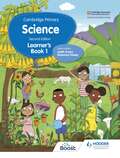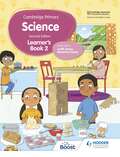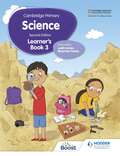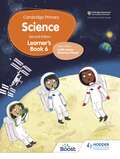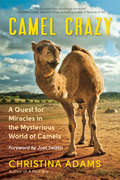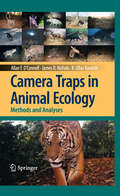- Table View
- List View
Cambridge Planetary Science: Asteroids:
by Burbine Thomas H.Asteroid science is a fundamental topic in planetary science and is key to furthering our understanding of planetary formation and the evolution of the Solar System. Ground-based observations and missions have provided a wealth of new data in recent years, and forthcoming missions promise further exciting results. This accessible book presents a comprehensive introduction to asteroid science, summarising the astronomical and geological characteristics of asteroids. The interdisciplinary nature of asteroid science is reflected in the broad range of topics covered, including asteroid and meteorite classification, chemical and physical properties of asteroids, observational techniques, cratering, and the discovery of asteroids and how they are named. Other chapters discuss past, present and future space missions and the threat that these bodies pose for Earth. Based on an upper-level course on asteroids and meteorites taught by the author, this book is ideal for students, researchers and professional scientists looking for an overview of asteroid science.
Cambridge Planetary Science: The Atmosphere and Climate of Mars (Cambridge Planetary Science #18)
by Smith Richard W. Robert M. Michael D. Clancy Haberle R. Todd François Forget ZurekHumanity has long been fascinated by the planet Mars. Was its climate ever conducive to life? What is the atmosphere like today and why did it change so dramatically over time? Eleven spacecraft have successfully flown to Mars since the Viking mission of the 1970s and early 1980s. These orbiters, landers and rovers have generated vast amounts of data that now span a Martian decade (roughly eighteen years). This new volume brings together the many new ideas about the atmosphere and climate system that have emerged, including the complex interplay of the volatile and dust cycles, the atmosphere-surface interactions that connect them over time, and the diversity of the planet's environment and its complex history. Including tutorials and explanations of complicated ideas, students, researchers and non-specialists alike are able to use this resource to gain a thorough and up-to-date understanding of this most Earth-like of planetary neighbours.
Cambridge Primary Revise for Primary Checkpoint Science Study Guide
by Rosemary Feasey Andrea MapplebeckBuild, reinforce and assess knowledge with additional practice and revision activities for all strands of the Cambridge Primary curriculum frameworks.- Boost confidence and check students' progress with review tests and practice questions.- Improve technique with a range of engaging activities and worked examples.- Consolidate knowledge with key content presented in a manageable and focussed format.The Cambridge Primary Revise for Study Guides can be used independently for homework or additionalpractice, or alongside the Teacher's Guides in the classroom.This resource has not been through the Cambridge International endorsement process.
Cambridge Primary Revise for Primary Checkpoint Science Teacher's Handbook
by Rosemary Feasey Andrea MapplebeckFocus revision where learners need most support and ensure coverage of the Cambridge Primary curriculum frameworks with clearly identified learning objectives and easy-to-follow teaching notes.- Assess knowledge and progress with structured practice tests and whole-class activities.-Improve understanding and technique with photocopiable resources such as model texts, practice questions and games.This resource has not been through the Cambridge International endorsement process.
Cambridge Primary Revise for Primary Checkpoint World English Teacher's Handbook
by Jennifer PeekFocus revision where learners need most support and ensure coverage of the Cambridge Primary curriculum frameworks with clearly identified learning objectives and easy-to-follow teaching notes.- Assess knowledge and progress with structured practice tests and whole-class activities.-Improve understanding and technique with photocopiable resources such as model texts, practice questions and games.This resource has not been through the Cambridge International endorsement process.
Cambridge Primary Science Learner's Book 1 Second Edition
by Hellen Ward Helen Lewis Rosemary Feasey Deborah Herridge Andrea Mapplebeck Tara LievesleyThis title has been endorsed by Cambridge Assessment International Education Master the essential scientific concepts that underpin the new Cambridge Primary Science curriculum framework (0097), with specifically sign-posted tasks, activities and investigations rooted in the mastery approach.- Get learners thinking scientifically, with engaging activities designed to show Science in Context; including topics on how science is used in the home and the impact it has on our environment.- Focus on key concepts and principles with starter activities at the beginning of each unit, allowing teachers to establish current knowledge and plan future lessons.- Extend student's knowledge with 'Challenge yourself!' activities to push problem-solving further.
Cambridge Primary Science Learner's Book 2 Second Edition
by Hellen Ward Helen Lewis Rosemary Feasey Deborah Herridge Andrea Mapplebeck Tara LievesleyThis title has been endorsed by Cambridge Assessment International EducationMaster the essential scientific concepts that underpin the new Cambridge Primary Science curriculum framework (0097), with specifically sign-posted tasks, activities and investigations rooted in the mastery approach.- Get learners thinking scientifically, with engaging activities designed to show Science in Context; including topics on how science is used in the home and the impact it has on our environment.- Focus on key concepts and principles with starter activities at the beginning of each unit, allowing teachers to establish current knowledge and plan future lessons.- Extend student's knowledge with 'Challenge yourself!' activities to push problem-solving further.
Cambridge Primary Science Learner's Book 3 Second Edition
by Hellen Ward Helen Lewis Rosemary Feasey Deborah Herridge Andrea Mapplebeck Tara LievesleyThis title has been endorsed by Cambridge Assessment International EducationMaster the essential scientific concepts that underpin the new Cambridge Primary Science curriculum framework (0097), with specifically sign-posted tasks, activities and investigations rooted in the mastery approach.- Get learners thinking scientifically, with engaging activities designed to show Science in Context; including topics on how science is used in the home and the impact it has on our environment.- Focus on key concepts and principles with starter activities at the beginning of each unit, allowing teachers to establish current knowledge and plan future lessons.- Extend student's knowledge with 'Challenge yourself!' activities to push problem-solving further.
Cambridge Primary Science Learner's Book 4 Second Edition
by Hellen Ward Helen Lewis Rosemary Feasey Deborah Herridge Andrea Mapplebeck Tara LievesleyThis title has been endorsed by Cambridge Assessment International EducationMaster the essential scientific concepts that underpin the new Cambridge Primary Science curriculum framework (0097), with specifically sign-posted tasks, activities and investigations rooted in the mastery approach.- Get learners thinking scientifically, with engaging activities designed to show Science in Context; including topics on how science is used in the home and the impact it has on our environment.- Focus on key concepts and principles with starter activities at the beginning of each unit, allowing teachers to establish current knowledge and plan future lessons.- Extend student's knowledge with 'Challenge yourself!' activities to push problem-solving further.
Cambridge Primary Science Learner's Book 5 Second Edition
by Hellen Ward Helen Lewis Rosemary Feasey Deborah Herridge Andrea Mapplebeck Tara LievesleyThis title has been endorsed by Cambridge Assessment International Education Master the essential scientific concepts that underpin the new Cambridge Primary Science curriculum framework (0097), with specifically sign-posted tasks, activities and investigations rooted in the mastery approach. - Get learners thinking scientifically, with engaging activities designed to show Science in Context; including topics on how science is used in the home and the impact it has on our environment. - Focus on key concepts and principles with starter activities at the beginning of each unit, allowing teachers to establish current knowledge and plan future lessons. - Extend student's knowledge with 'Challenge yourself!' activities to push problem-solving further.
Cambridge Primary Science Learner's Book 6 Second Edition
by Hellen Ward Helen Lewis Rosemary Feasey Deborah Herridge Andrea Mapplebeck Tara LievesleyThis title has been endorsed by Cambridge Assessment International EducationMaster the essential scientific concepts that underpin the new Cambridge Primary Science curriculum framework (0097), with specifically sign-posted tasks, activities and investigations rooted in the mastery approach.- Get learners thinking scientifically, with engaging activities designed to show Science in Context; including topics on how science is used in the home and the impact it has on our environment.- Focus on key concepts and principles with starter activities at the beginning of each unit, allowing teachers to establish current knowledge and plan future lessons.- Extend student's knowledge with 'Challenge yourself!' activities to push problem-solving further.
Cambridge Scientific Minds
by Simon Mitton Peter HarmanSince the 'scientific revolution' of the seventeenth century, a great number of distinguished scientists and mathematicians have been associated with the University of Cambridge. Cambridge Scientific Minds provides a portrait of some of the most eminent scientists associated with the University over the past 400 years, including accounts of the work of three of the greatest figures in the entire history of science, Isaac Newton, Charles Darwin and James Clerk Maxwell. The chronological balance reflects the increasing importance of science in the recent history of the University. The book comprises personal memoirs and historical essays, including contributions by leading Cambridge scientists. Cambridge Scientific Minds will be of interest not only to graduates of the University, science students and historians of science, but to anyone wishing to gain an insight into some of the greatest scientific minds in history.
Cambridge Series in Chemical Engineering: Design and Processing of Particulate Products
by Jim LitsterWith this unique and comprehensive text, readers will gain the quantitative tools needed to engineer the particulate processes and products that are ubiquitous in modern life. Covering a series of particle and particulate delivery form design processes, with emphasis on design and operation to control particle attributes, and supported by many worked examples, it is essential reading for students and practitioners. Topics covered include a range of particle design processes such as crystallization and precipitation, granulation, grinding, aerosol processes and spray drying, as well as forms of delivery such as granules, tablets, dry powders, and aerosols. Readers will learn from real-world examples how the primary particle properties and the structure and properties of the delivery form can lead to high performance products, ranging from pharmaceuticals, consumer goods and foods, to specialty chemicals, paints, agricultural chemicals and minerals.
Cambridge Series in Chemical Engineering: Introduction to Chemical Engineering Fluid Mechanics
by William M. DeenDesigned for introductory undergraduate courses in fluid mechanics for chemical engineers, this stand-alone textbook illustrates the fundamental concepts and analytical strategies in a rigorous and systematic, yet mathematically accessible manner. Using both traditional and novel applications, it examines key topics such as viscous stresses, surface tension, and the microscopic analysis of incompressible flows which enables students to understand what is important physically in a novel situation and how to use such insights in modeling. The many modern worked examples and end-of-chapter problems provide calculation practice, build confidence in analyzing physical systems and help develop engineering judgment. The book also features a self-contained summary of the mathematics needed to understand vectors and tensors, and explains solution methods for partial differential equations. Including a full solutions manual for instructors available at www. cambridge. org/deen, this balanced textbook is the ideal resource for a one-semester course.
Cambridge Studies in Biological and Evolutionary Anthropology: The Dwarf and Mouse Lemurs of Madagascar
by Lehman, Shawn M. and Radespiel, Ute and Zimmermann, Elke Shawn M. Lehman Ute Radespiel Elke ZimmermannThe dwarf and mouse lemurs of Madagascar are two very species-rich lemur genera, yet there is a relative paucity of information on this primate family in published literature. In this first ever treatment of the Cheirogaleidae, international experts are brought together to review and integrate our current knowledge of the behaviour, physiology, ecology, genetics and biogeography of these species. A wide range of direct and indirect research methods that are currently used to study these cryptic nocturnal solitary foragers are described. By uniting often disparate research on captive and free-ranging taxa and synthesising recent methodological advances, this book provides new insights that will encourage further studies of this fascinating primate family. This synthesis will provide an incentive for more integrative studies of the Cheirogaleidae in captivity and in the wild, enabling the impacts of deforestation and other factors to be identified and directions for future conservation efforts to be established.
Cambridge Studies in Law and Society: The Clinic and the Court
by Tobias Kelly Ian Harper Harper, Ian and Kelly, Tobias and Khanna, Akshay Akshay KhannaLaw and medicine can be caught in a tight embrace. They both play a central role in the politics of harm, making decisions regarding what counts as injury and what might be the most suitable forms of redress or remedy. But where do law and medicine converge and diverge in their responses to and understandings of harm and suffering? Using empirical case studies from Europe, the Americas and Africa, The Clinic and the Court brings together leading medical and legal anthropologists to explore this question.
Cambridge Studies in Morphology and Molecules: Evolution of the Rodents
by Cox, Philip G. and Hautier, Lionel Philip G. Cox Lionel HautierThe widespread use of mouse models in developmental, behavioural and genetic studies has sparked wider interest in rodent biology as a whole. This book brings together the latest research on rodents to better understand the evolution of both living and extinct members of this fascinating group. Topics analysed include the role of molecular techniques in the determination of robust phylogenetic frameworks; how geometric morphometric methods help quantify and analyse variation in shape; and the role of developmental biology in elucidating the origins of skeletal elements and the teeth. The editors unite these disciplines to present the current state of knowledge in rodent biology, whilst setting the landscape for future research. This book highlights interdisciplinary links across palaeontology, developmental biology, functional morphology, phylogenetics and biomechanics, making it a valuable resource for evolutionary biologists in all fields.
Cambridge Texts in Biomedical Engineering: Biomedical Engineering
by W. Mark SaltzmanThis is an ideal text for an introduction to biomedical engineering. The book presents the basic science knowledge used by biomedical engineers at a level accessible to all students and illustrates the first steps in applying this knowledge to solve problems in human medicine. Biomedical engineering now encompasses a range of fields of specialization including bioinstrumentation, bioimaging, biomechanics, biomaterials, and biomolecular engineering. This introduction to bioengineering assembles foundational resources from molecular and cellular biology and physiology and relates them to various sub-specialties of biomedical engineering. The first two parts of the book present basic information in molecular/cellular biology and human physiology; quantitative concepts are stressed in these sections. Comprehension of these basic life science principles provides the context in which biomedical engineers interact. The third part of the book introduces the sub-specialties in biomedical engineering, and emphasizes - through examples and profiles of people in the field - the types of problems biomedical engineers solve.
Cambridge Texts in Biomedical Engineering: Quantitative Biomedical Optics
by Bigio, Irving J. and Fantini, Sergio Irving J. Bigio Sergio FantiniThis is the textbook and reference resource that instructors, students, and researchers in biomedical optics have been waiting for. Comprehensive and up to date, it covers a broad range of areas in biomedical optics, from light interactions at the single-photon and single-biomolecule levels, to the diffusion regime of light propagation in tissue. Subjects covered include spectroscopic techniques (fluorescence, Raman, infrared, near-infrared, and elastic scattering), imaging techniques (diffuse optical tomography, photoacoustic imaging, several forms of modern microscopy, and optical coherence tomography), and laser-tissue interactions, including optical tweezers. Topics are developed from the fundamental principles of physical science, with intuitive explanations, while rigorous mathematical formalisms of theoretical treatments are also provided. For each technique, descriptions of relevant instrumentation and examples of biomedical applications are outlined, and each chapter benefits from references and suggested resources for further reading, and exercise problems with answers to selected problems.
Camel Clinical Biochemistry and Hematology
by Bernard Faye Mohammed BengoumiThis work brings together a wealth of data regarding the reference values and factors of variation in biochemical parameters used by camel veterinarians and scientists to determine these animals’ nutritional and clinical status. It also explores several technical aspects involved in determining these parameters, sampling procedures, and essential elements in the interpretation of the results. Though many texts are available on small and large ruminants, much less is known about species confined to the marginal zones of tropical and Mediterranean countries, such as camels. This book addresses precisely this research gap, on the one hand by presenting an extensive review of the literature, and on the other by synthesizing the outcomes of the authors’ numerous previous works. In veterinary medicine, blood tests to help diagnose diseases in cattle were first proposed nearly a century ago, but were mainly developed in the 1960s, initially at specialized research or veterinary services laboratories, and eventually, with the advent of new equipment and the miniaturization of the analyzers, finding their way into veterinarians’ cabinets. Beyond their diagnostic value, veterinary surgeons and zootechnicians also speculated on the potential use of blood tests to evaluate animals’ nutritional status. Thus, a whole range of analyses are now proposed to the stakeholders responsible for animal health. Such analyses could help to define a metabolic profile, which would offer a valuable decision-making tool for experts and researchers alike.
Camel Crazy: A Quest for Miracles in the Mysterious World of Camels
by Christina AdamsIn this page-turning odyssey, a mother on a mission travels the globe — from Bedouin camps in the Middle East to Amish farms in Pennsylvania to camel-herder villages in India — to obtain camel milk, which dramatically helps her son’s autism symptoms. Chronicling bureaucratic roadblocks, adventure-filled detours, and Christina Adams’s love-fueled determination, Camel Crazy explores why camels are cherished as family members and hailed as healers. Adams’s work uncovers studies of camel milk for possible treatment of autism, allergies, diabetes, and immune dysfunction, as well as ancient traditions of healing. But the most fascinating aspect of Adams’s discoveries is the gentle-eyed, mischievous camels themselves. Huge and often unpredictable, they are amazingly intelligent and adaptable. This moving and rollicking ode to “camel people” and the creatures they adore reveals the ways camels touch lives around the world. Includes users’ and buyers’ guides to camel’s milk
Camels (Nature's Children)
by Susie DawsonIn this book you will learn what the camel's hump is really for, why they have such long eye lashes, and why they are called the ships of the desert.
Camera Eppadi Iyangukirathu?
by N. ChokkanThis book describes the functioning of various types of cameras which would be very useful to all people interested in photography.
Camera Traps in Animal Ecology: Methods and Analyses
by K. Ullas Karanth James D. Nichols Allan F. O'ConnellRemote photography and infrared sensors are widely used in the sampling of wildlife populations worldwide, especially for cryptic or elusive species. Guiding the practitioner through the entire process of using camera traps, this book is the first to compile state-of-the-art sampling techniques for the purpose of conducting high-quality science or effective management. Chapters on the evaluation of equipment, field sampling designs, and data analysis methods provide a coherent framework for making inferences about the abundance, species richness, and occupancy of sampled animals. The volume introduces new models that will revolutionize use of camera data to estimate population density, such as the newly developed spatial capture-recapture models. It also includes richly detailed case studies of camera trap work on some of the world's most charismatic, elusive, and endangered wildlife species. Indispensible to wildlife conservationists, ecologists, biologists, and conservation agencies around the world, the text provides a thorough review of the subject as well as a forecast for the use of remote photography in natural resource conservation over the next few decades.
Cameras and Display Systems Towards Photorealistic 3D Holography (Series in Display Science and Technology)
by Jin Li Yi Zhang Jintao Hong Xiaoxun Li Zilong Liu Yanyan Liu Daping ChuThis book presents recent advances in three-dimensional (3D) imaging and display frameworks, encompassing three categories of 3D imaging and display technologies. The first category is nonphotorealistic 3D approaches based on conventional optical cameras to implement 3D stereoscopic observation of a scene. In the context of nonphotorealistic 3D imaging and reconstruction systems, the authors introduce general principles and also demonstrate camera calibration for 3D imaging, smart cameras, and full-link imaging methods using the optical modulation transfer function to improve imaging quality in conventional cameras. The second category is based on light-ray light field technology to achieve photorealistic 3D imaging and displays. In the context of light-ray light field systems, two approaches capable of light-ray light field 3D imaging by utilizing a camera array or a lens array are demonstrated. Accordingly, light-ray light field display approaches comprising head-mounted displays and integral displays are also introduced. The third category is also photorealistic 3D imaging and display technology, which is based on holography (i.e., diffraction or wavefront light field). In the corresponding holographic displays, the authors introduce 3D holographic displays from three elements: algorithms, devices, and systems, involving fast hologram generation algorithms, wide-viewing-angle display systems, and metasurface holography, etc. Including an investigative roadmap for future progress in optical imaging and 3D display systems, this book is essential reading for scientists and engineers in academia and industry who are interested in next-generation imaging and display concepts for 3D visual sensing systems.





